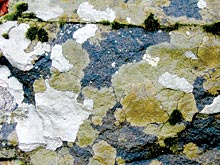What a blessing it is that we don’t live in a perpetually warm climate. To my mind, winters in Western North Carolina are just about perfect. They’re not upstate-New York brutal, but they do provide a true respite from the intense activity, both mental and physical, that fills the other three-quarters of the obsessive gardener’s year.

Winter is often depicted as the season of armchair gardening, full of daydreams and glossy catalogs. And I do enjoy my catalogs and time spent on the Web perusing, parsing and purchasing, especially on blustery days when it’s really not any fun to be outside. But the rest of the time, I love to be outdoors in the winter garden.
Simply being in the resting garden can be remarkably rewarding. Because the eye is not distracted and overwhelmed by the bounty that typifies the other three seasons, it’s a particularly good time to practice noticing and appreciating the subtler aspects of the natural world. When else would you put your attention to the remarkable flower buds of deciduous azaleas, which, on close inspection, resemble the finest cloisonné? In their intricacy, they are almost as spectacular as the unfurled blossoms themselves.
Each season has some signature feature that we think of as quintessential: trilliums in April; peonies in May; roses in June. For me, the finest distillate of winter is the emergence of the Lilliputian world of mosses and lichens from the background they inhabit during much of the year. These humble members of the plant and fungus worlds are at their most resplendent on a cold, misty day.
“Resplendent,” some may argue, seems much too grand a word to describe things like mosses and lichens. Shouldn’t such terms be reserved for plant royalty? I don’t think so. There are so many species, and they offer such a remarkable variety of color—who knew there could be so many soft shades of green and grey?—texture, pattern and form. You simply have to take the time to notice.
And if you’re so unfortunate as not to have a garden, a grey winter day provides the perfect excuse to get out on your favorite trail and take a moss-and-lichen walk. Any natural area is replete with them. If you have a hand lens, bring it along to help you get up close and personal.
Mosses are expertly explored by George Schenk in his beautifully illustrated book Moss Gardening (Timber Press, 1997). Unlike most of the plants we grow, mosses ask for very little in the way of care. What they primarily need from us is just to be left alone and kept from getting covered up by leaves, mulch and more vigorous plants.
Moss is far more satisfying than the ratty lawns we’ve all seen struggling in the shade. The obvious solution is to get rid of the grass and let the moss have its way. If you’re not a purist, you can spray the area with an herbicide such as Roundup, which will kill the grass but doesn’t bother moss; otherwise you can weed out the remaining grass and stray weeds and the moss will colonize the area on its own, asking for nothing but a little patience.
As with so many aspects of gardening, the Japanese have a highly developed aesthetic that values moss and lichens more than Western gardening traditions do. They’ve made moss a major component of their gardens. To see the possibilities, check out a book on Japanese gardens or peruse Schenk’s work.
Another element of that same aesthetic is a strong emphasis on and appreciation of stone. Motifs of stone, moss and lichen form an integral part of Japanese gardens. But you can incorporate those three elements into any garden style. Stone is another garden feature that’s best appreciated in winter, when the distractions of the burgeoning plant world are minimized. Like the mosses and lichens that often enhance its surface, stone is at its best in diffuse light with a patina of moisture to intensify color and pattern.
Stones—especially natural, irregular ones that are indigenous to our area—can do as much for the winter garden as any other element. They set off and enhance any plant, whether it’s a dwarf conifer, cyclamen, partridgeberry or moss. Like mature trees, big stones or boulders also add a sense of gravitas, helping unify and ground the garden. They create a strong sense of place, something many gardens lack. Especially pronounced at this time of year, this grounding effect is one of the most satisfying aspects of spending time in the winter garden.
Spring is rapidly approaching, with ‘Sweet Betsy’ trillium and shooting stars pushing up through the leaf litter. I won’t pretend that I don’t relish the anticipation of spring’s delights, but I have loved a winter spent among the massive stones and their delicate cohorts, perfect in every way a gardener could wish.
[Garden designer Edmund Taylor lives in Madison County. He can be reached at swallowtailgardendesigns@hughes.net.]



Before you comment
The comments section is here to provide a platform for civil dialogue on the issues we face together as a local community. Xpress is committed to offering this platform for all voices, but when the tone of the discussion gets nasty or strays off topic, we believe many people choose not to participate. Xpress editors are determined to moderate comments to ensure a constructive interchange is maintained. All comments judged not to be in keeping with the spirit of civil discourse will be removed and repeat violators will be banned. See here for our terms of service. Thank you for being part of this effort to promote respectful discussion.